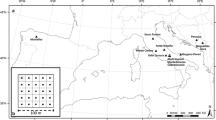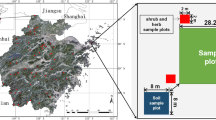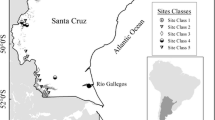Abstract
Soils play a significant role in climate regulation, especially due to soil organic carbon (SOC). The SOC pool is therefore modeled for various environments, and forest floor and topsoil thicknesses are important parameters for most of these models as they store most of the SOC. However, the forest floor and topsoil thicknesses show high spatial variability which is a result of multiple factors which are not agreed upon among scientists. Out of these factors, we choose topography parameters (elevation, slope, and topography wetness index) and forest stand characteristics (stand age, dominant tree species, and forest floor cover), and soil moisture, and we analyzed their relationship to the forest floor and topsoil thicknesses. The study was performed in a managed submontaneous forest in Central Europe dominated by Picea abies (L.) Karsten with small patches of Fagus sylvatica L. or other species. The thicknesses of the O horizons (Oi, Oe, Oa) and topsoil were measured at 221 sampling pits. Geographically weighted regression showed that the spatial variability of the overall forest floor plus topsoil thickness (OA) is responsible for 8% of its variability. The thickness of the OA is the most strongly controlled by forest floor cover explaining approximately 6% of its variability and soil moisture explaining 2–6% of the variability. The Oi + Oe horizon thickness is controlled only by forest floor cover explaining 10.7% of its variability, and the thickness of Oa + A horizon can be explained mainly by soil moisture in mineral horizon explaining 9% of the variability.
Similar content being viewed by others
Data availability
The datasets generated and analyzed during the current study are available from the corresponding author on reasonable request.
Code availability
Not applicable.
References
Adhikari K, Hartemink AE (2016) Linking soils to ecosystem services—a global review. Geoderma 262:101–111. https://doi.org/10.1016/j.geoderma.2015.08.009
Ahmed IU, Smith AR, Jones DL, Godbold DL (2016) Tree species identity influences the vertical distribution of labile and recalcitrant carbon in a temperate deciduous forest soil. For Ecol Manag 359:352–360. https://doi.org/10.1016/j.foreco.2015.07.018
Anschlag K, Tatti D, Hellwig N et al (2017) Vegetation-based bioindication of humus forms in coniferous mountain forests. J Mt Sci 14:662–673. https://doi.org/10.1007/s11629-016-4290-y
Bastianelli C, Ali AA, Beguin J et al (2017) Boreal coniferous forest density leads to significant variations in soil physical and geochemical properties. Biogeosciences 14:3445–3459. https://doi.org/10.5194/bg-14-3445-2017
Bens O, Buczko U, Sieber S, Hüttl RF (2006) Spatial variability of O layer thickness and humus forms under different pine beech-forest transformation stages in NE Germany. J Plant Nutr Soil Sci 169:5–15. https://doi.org/10.1002/jpln.200521734
Bens O, Wahl NA, Fischer H, Hüttl RF (2007) Water infiltration and hydraulic conductivity in sandy cambisols: impacts of forest transformation on soil hydrological properties. Eur J For Res 126:101–109. https://doi.org/10.1007/s10342-006-0133-7
Brahim N, Ibrahim H, Hatira A (2014) Tunisian soil organic carbon stock—spatial and vertical variation. Procedia Eng 69:1549–1555. https://doi.org/10.1016/j.proeng.2014.03.154
Bruckner A, Kandeler E, Kampichler C (1999) Plot-scale spatial patterns of soil water content, pH, substrate-induced respiration and N mineralization in a temperate coniferous forest. Geoderma 93:207–223. https://doi.org/10.1016/S0016-7061(99)00059-2
Chuman T, Gürtlerová P, Hruška J, Adamová M (2014) Geochemical reactivity of rocks of the Czech Republic. J Maps 10:341–349. https://doi.org/10.1080/17445647.2013.867418
Conforti M, Lucà F, Scarciglia F et al (2016) Soil carbon stock in relation to soil properties and landscape position in a forest ecosystem of southern Italy (Calabria region). CATENA 144:23–33. https://doi.org/10.1016/j.catena.2016.04.023
Cremer M, Kern NV, Prietzel J (2016) Soil organic carbon and nitrogen stocks under pure and mixed stands of European beech, Douglas fir and Norway spruce. For Ecol Manag 367:30–40. https://doi.org/10.1016/j.foreco.2016.02.020
CUZK (2006) ZABAGED: database of geographic data of the Czech republic. https://geoportal.cuzk.cz
De Nicola C, Zanella A, Testi A et al (2014) Humus forms in a Mediterranean area (Castelporziano Reserve, Rome, Italy): classification, functioning and organic carbon storage. Geoderma 235–236:90–99. https://doi.org/10.1016/j.geoderma.2014.06.033
de Wit HA, Eldhuset TD, Mulder J (2010) Dissolved Al reduces Mg uptake in Norway spruce forest: results from a long-term field manipulation experiment in Norway. For Ecol Manag 259:2072–2082. https://doi.org/10.1016/j.foreco.2010.02.018
Essington ME (2015) Soil and water chemistry: an integrative approach, 2nd edn. CRC Press, Boca Raton
Fotheringham AS, Brudson C, Charlton M (2002) Geographically weighted regression: the analysis of spatially varying relationships. Wiley, Chichester
Francaviglia R, Renzi G, Doro L et al (2017) Soil sampling approaches in Mediterranean agro-ecosystems. Influence on soil organic carbon stocks. CATENA 158:113–120. https://doi.org/10.1016/j.catena.2017.06.014
Hansson K, Fröberg M, Helmisaari H et al (2013) Carbon and nitrogen pools and fluxes above and below ground in spruce, pine and birch stands in southern Sweden. For Ecol Manag 309:28–35. https://doi.org/10.1016/j.foreco.2013.05.029
Heim A, Wehrli L, Eugster W, Schmidt MWI (2009) Effects of sampling design on the probability to detect soil carbon stock changes at the Swiss CarboEurope site Lägeren. Geoderma 149:347–354. https://doi.org/10.1016/j.geoderma.2008.12.018
ISO 11277 (2009) Soil quality—determination of particle size distribution in mineral soil material—method by sieving and sedimentation
Kristensen T, Ohlson M, Bolstad P, Nagy Z (2015) Spatial variability of organic layer thickness and carbon stocks in mature boreal forest stands—implications and suggestions for sampling designs. Environ Monit Assess. https://doi.org/10.1007/s10661-015-4741-x
Laamrani A, Valeria O, Bergeron Y et al (2014a) Effects of topography and thickness of organic layer on productivity of black spruce boreal forests of the Canadian Clay Belt region. For Ecol Manag 330:144–157. https://doi.org/10.1016/j.foreco.2014.07.013
Laamrani A, Valeria O, Fenton N et al (2014b) The role of mineral soil topography on the spatial distribution of organic layer thickness in a paludified boreal landscape. Geoderma 221–222:70–81. https://doi.org/10.1016/j.geoderma.2014.01.003
Labaz B, Galka B, Bogacz A et al (2014) Factors influencing humus forms and forest litter properties in the mid-mountains under temperate climate of southwestern Poland. Geoderma 230–231:265–273. https://doi.org/10.1016/j.geoderma.2014.04.021
Lexer MJ, Hönninger K (1998) Estimating physical soil parameters for sample plots of large-scale forest inventories. For Ecol Manag 111:231–247. https://doi.org/10.1016/S0378-1127(98)00335-1
Liski J (1995) Variation in soil organic carbon and thickness of soil horizons within a boreal forest stand—effect of trees and implications for sampling. Silva Fenn 29:255–266
Marty C, Houle D, Gagnon C (2015) Variation in stocks and distribution of organic C in soils across 21 eastern Canadian temperate and boreal forests. For Ecol Manag 345:29–38. https://doi.org/10.1016/j.foreco.2015.02.024
Mulder J, De Wit HA, Boonen HW, Bakken LR (2001) Increased levels of aluminium in forest soils: effects on the stores of soil organic carbon. Water Air Soil Pollut 130:989–994
Muukkonen P, Häkkinen M, Mäkipää R (2009) Spatial variation in soil carbon in the organic layer of managed boreal forest soil-implications for sampling design. Environ Monit Assess 158:67–76. https://doi.org/10.1007/s10661-008-0565-2
Nakaya T, Charlton M, Brunsdon C et al (2009) GWR 4.09 software. https://gwr4.software.informer.com/
Olsson MT, Erlandsson M, Lundin L et al (2009) Organic carbon stocks in Swedish podzol soils in relation to soil hydrology and other site characteristics. Silva Fenn 43:209–222
Oulehle F, Kopáček J, Chuman T et al (2016) Predicting sulphur and nitrogen deposition using a simple statistical method. Atmos Environ. https://doi.org/10.1016/j.atmosenv.2016.06.028
Oulehle F, Chuman T, Hruška J et al (2017) Recovery from acidification alters concentrations and fluxes of solutes from Czech catchments. Biogeochemistry 132:251–272. https://doi.org/10.1007/s10533-017-0298-9
Oulehle F, Tahovská K, Chuman T et al (2018) Comparison of the impacts of acid and nitrogen additions on carbon fluxes in European conifer and broadleaf forests. Environ Pollut 238:884–893. https://doi.org/10.1016/j.envpol.2018.03.081
Peltoniemi M, Mäkipää R, Liski J, Tamminen P (2004) Changes in soil carbon with stand age—an evaluation of a modelling method with empirical data. Glob Change Biol 10:2078–2091. https://doi.org/10.1111/j.1365-2486.2004.00881.x
Persson T, Lundkvist H, Wirén A et al (1989) Effects of acidification and liming on carbon and nitrogen mineralization and soil organisms in mor humus. Water Air Soil Pollut 45:77–96
Ponge JF, Jabiol B, Gegout JC (2011) Geology and climate conditions affect more humus forms than forest canopies at large scale in temperate forests. Geoderma 162:187–195
Pregitzer KS, Euskirchen ES (2004) Carbon cycling and storage in world forests: biome patterns related to forest age. Glob Change Biol 10:2052–2077. https://doi.org/10.1111/j.1365-2486.2004.00866.x
Rossi J, Govaerts A, De Vos B et al (2009) Spatial structures of soil organic carbon in tropical forests-a case study of Southeastern Tanzania. CATENA 77:19–27. https://doi.org/10.1016/j.catena.2008.12.003
Rothe A, Kreutzer K, Kuchenhoff H (2002) Influence of tree species composition on soil and soil solution properties in two mixed spruce-beech stands with contrasting history in Southern Germany. Plant Soil 240:47–56. https://doi.org/10.1023/A:1015822620431
Šamonil P, Valtera M, Bek S et al (2011) Soil variability through spatial scales in a permanently disturbed natural spruce-fir-beech forest. Eur J For Res 130:1075–1091. https://doi.org/10.1007/s10342-011-0496-2
Schöning I, Totsche KU, Kögel-Knabner I (2006) Small scale spatial variability of organic carbon stocks in litter and solum of a forested Luvisol. Geoderma 136:631–642. https://doi.org/10.1016/j.geoderma.2006.04.023
Smit A (1999) The impact of grazing on spatial variability of humus profile properties in a grass-encroached Scots pine ecosystem. CATENA 36:85–98. https://doi.org/10.1016/S0341-8162(99)00003-X
Sorensen R, Zinko U, Seibert J (2006) On the calculation of the topographic wetness index: evaluation of different methods based on field observations. Hydrol Hydrol Earth Syst Sci Earth Syst Sci 10:101–112
Strand LT, Callesen I, Dalsgaard L, de Wit HA (2016) Carbon and nitrogen stocks in Norwegian forest soils—the importance of soil formation, climate, and vegetation type for organic matter accumulation. Can J For Res 1473:1–15. https://doi.org/10.1139/cjfr-2015-0467
Trap J, Hättenschwiler S, Gattin I, Aubert M (2013) Forest ageing: an unexpected driver of beech leaf litter quality variability in European forests with strong consequences on soil processes. For Ecol Manag 302:338–345. https://doi.org/10.1016/j.foreco.2013.03.011
ÚHÚL (2015) Forest Management Institute. In: For. Inf. www.uhul.cz/mapy-a-data/
Valtera M, Šamonil P, Boublík K (2013) Soil variability in naturally disturbed Norway spruce forests in the Carpathians: Bridging spatial scales. For Ecol Manag 310:134–146. https://doi.org/10.1016/j.foreco.2013.08.004
Viewegh J (2003) Klasifikace lesních rostlinných společenstev (se zaměřením na Typologický systém ÚHÚL). Česká zemědělská univerzita v Praze, Praha
Wang G, Mao T, Chang J, Du J (2014) Impacts of surface soil organic content on the soil thermal dynamics of alpine meadows in permafrost regions: data from fi eld observations. Geoderma 232–234:414–425. https://doi.org/10.1016/j.geoderma.2014.05.016
Wiesmeier M, Urbanski L, Hobley E et al (2019) Soil organic carbon storage as a key function of soils—a review of drivers and indicators at various scales. Geoderma 333:149–162. https://doi.org/10.1016/j.geoderma.2018.07.026
Yu Z, Apps MJ, Bhatti JS (2002) Implications of floristic and environmental variation for carbon cycle dynamics in boreal forest ecosystems of central Canada. J Veg Sci 13:327–340. https://doi.org/10.1111/j.1654-1103.2002.tb02057.x
Acknowledgements
This research was supported by the institutional resources of the Ministry of Education, Youth and Sports of the Czech Republic for the support of science and research, Project No. SVV260438, and by Global Change Research Institute of the Czech Academy of Sciences. We thank M. Tesar for enabling us to carry out the field work at the LIZ catchment operated by the Institute of Hydrodynamics, The Czech Academy of Sciences.
Funding
This research was supported by the institutional resources of the Ministry of Education, Youth and Sports of the Czech Republic for the support of science and research, Project No. SVV260438, and by Global Change Research Institute of the Czech Academy of Sciences.
Author information
Authors and Affiliations
Corresponding author
Ethics declarations
Conflict of interest
The authors declare that they have no conflict of interest.
Additional information
Communicated by Agustín Merino.
Publisher's Note
Springer Nature remains neutral with regard to jurisdictional claims in published maps and institutional affiliations.
Annex
Annex
Annex 1: Location of the study catchment and the position of the sampling points

Annex 2: Soil type distribution in LIZ catchment
Map of soil types based on 30 randomly distributed sampling cores down to 70 cm and refined by 300 sampling pits down to 25 cm.

Annex 3: Soil density and particle size distribution
Soil type | Horizon complex | Number of samples | Bulk density (g/cm3) | Particle density (g/cm3) | Sand (%) | Silt (%) | Clay (%) | Textural class |
|---|---|---|---|---|---|---|---|---|
Oi + Oe | 3 | 0.12 | – | – | – | – | ||
CMha | Oa + A | 3 | 0.63 | 2.48 | 57 | 37 | 5 | Sandy loam |
Mineral | 3 | 1.22 | 2.51 | 53 | 40 | 8 | Sandy loam | |
Oi + Oe | 3 | 0.14 | – | – | – | – | ||
CMdy | Oa + A | 3 | 0.46 | 2.03 | 57 | 36 | 7 | Sandy loam |
Mineral | 3 | 1.17 | 2.45 | 56 | 37 | 7 | Sandy loam | |
Oi + Oe | 3 | 0.09 | – | – | – | – | ||
PZet | Oa + A | 3 | 0.62 | 2.17 | 56 | 38 | 9 | Sandy loam |
Mineral | 3 | 1.10 | 2.49 | 64 | 30 | 6 | Sandy loam | |
Oi + Oe | 3 | 0.10 | – | – | – | – | ||
CMgl | Oa + A | 3 | 0.43 | 2.3 | 56 | 40 | 3 | Sandy loam |
Mineral | 3 | 1.81 | 2.5 | 53 | 40 | 8 | Sandy loam | |
Oi + Oe | 2 | 0.14 | – | – | – | – | ||
ST | Oa + A | 2 | 0.11 | 1.52 | 49 | 33 | 18 | Loam |
Mineral | 2 | 1.02 | 2.5 | 59 | 33 | 8 | Sandy loam | |
Oi + Oe | 2 | 0.04 | – | – | – | – | ||
GL | Oa + A | 2 | 0.50 | 2.45 | 53 | 38 | 9 | Sandy loam |
Mineral | 2 | 2.13 | 2.61 | 70 | 22 | 8 | Sandy loam |
Annex 4: Soil edaphic categories in LIZ catchment
Retrieved from maps produced by ÚHUL at scale 1:10,000 and based on the forest site classification described by Viewegh (2003).

Annex 5: Stand age in LIZ catchment
Retrieved from maps produced by ÚHUL at scale 1:10,000.

Annex 6 Geographically weighted regression computation details
In GWR 4.09, the fixed distance of Gaussian Kernel was left to find out by Golden selection search with the criterion of minimum AICc (AIC with a correction for small sample sizes). The categories of the categorical explanatory variables (forest floor cover, dominant tree species and forest stand age) were recoded as dummy variables. From the dummy variables representing the same categorical explanatory variable one was always omitted from the analysis due to multicollinearity (see Fotheringham et al. 2002). However, all of the dummy variables representing a particular categorical explanatory variable were analyzed and interpreted as one phenomenon.
The data were supposed spatially variable. On the other hand, no justification was found for the spatial variability of explanatory variables. For instance, slope or dominant tree species should influence the forest floor and topsoil thicknesses in the same way over the whole area. Furthermore, this assumption was verified by a geographical variability test embodied in GWR 4.09. No significant geographical variability was found for most explanatory variables with an exception of the forest floor cover. However, the data of explanatory variables was assumed to be geographically invariable as a whole. The explanatory variables were then classified to those with local influence (Intercept) and those with global influence (all the others) (see Fotheringham et al. 2002).
Local variables are computed locally from neighbor values within the bandwidth and weighted by their distance. As a result, there is not an exact estimation of their value in the model, the estimation could be slightly different at every location (Fotheringham et al. 2002). Locally computed intercept works similarly as an interpolation in this case, and substitutes a role of an autoregressive parameter which deals with the spatial autocorrelation. The spatial independency of the model residuum was verified by Moran’s I. The advantage of using the local intercept instead of the model without intercept but employing an autoregressive parameter is at first that it can be computed by Ordinary least squares method compared to the latter model which should be performed by Maximum likelihood computation and the second advantage is the interpretation which is more intuitive for the models with the intercept. The use of the local intercept and the autoregressive parameter at the same model is not possible due to their multicollinearity and a model combining a global intercept with an autoregressive parameter was less flexible.
The two above mentioned models which were run separately for Oi + Oe, Oa + A, and OA horizons can be written as follows:
where FLTHi = the thickness of a modeled horizon complex at location i, COV = forest floor cover, TREE = dominant tree species; AGE = forest stand age, ELEV = elevation, WETIN = wetness index, MOIST = moisture in the mineral soil measured in the field, SLOPE = slope, CURV = relief curvature, α1–α7 are model estimates, α0 is intercept estimate computed locally.
Annex 7: OA thickness variability

Annex 8: Variability of the thickness of Oi + Oe horizons' complex

Annex 9: Variability of the thickness of Oa + A horizon's complex

Annex 10: OA thickness variability at stands of oligotrophic edaphic category

Annex 11: The variability of the thickness of Oi + Oe horizon's complex at stands of oligotrophic edaphic category

Annex 12: The variability of the thickness of Oa + A horizon's complex at stands of oligotrophic edaphic category

Annex 13: OA thickness variability at stands of hydric edaphic category

Annex 14: The variability of the thickness of Oa + A horizon's complex at stands of hydric edaphic category

Annex 7–14: Oi—organic litter horizon, Oe—fragmented organic horizon, Oa—humified organic horizon, A—topsoil, OA—forest floor plus topsoil in total
Rights and permissions
About this article
Cite this article
Zajícová, K., Chuman, T. Spatial variability of forest floor and topsoil thicknesses and their relation to topography and forest stand characteristics in managed forests of Norway spruce and European beech. Eur J Forest Res 140, 77–90 (2021). https://doi.org/10.1007/s10342-020-01316-1
Received:
Revised:
Accepted:
Published:
Issue Date:
DOI: https://doi.org/10.1007/s10342-020-01316-1




